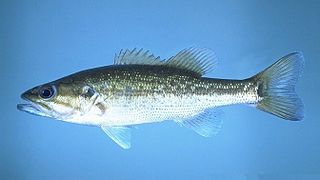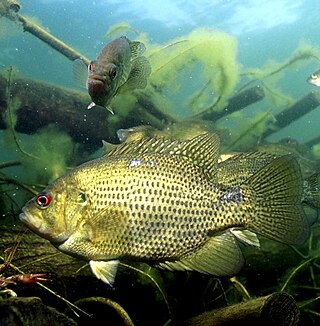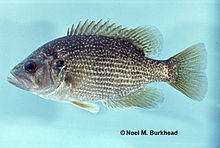
The spotted bass, also called spotty, or spots in various fishing communities, is a species of North American freshwater fish belonging to the sunfish family (Centrarchidae) of the order Perciformes. It is noted for the rows of dark spots below the lateral line, which give it its common name. One of the black basses, it is native to the Mississippi River basin and across the Gulf states, from central Texas through the Florida panhandle. Its native range extends into the western Mid-Atlantic states and it has been introduced into western North Carolina and Virginia. It has also been introduced to southern Africa, where it has become established in some isolated waters as an invasive species.

The redeye bass, redeye, or Coosa bass is a species of freshwater fish in the sunfish family (Centrarchidae) native to the Coosa River system of Georgia, Alabama. The waters it is normally found in are cool streams and rivers in the foothills of mountains.

The Suwannee bass is a species of freshwater fish in the sunfish family (Centrarchidae) of order Perciformes. One of the black basses, This species is native to just two river systems in Florida and Georgia, although it has been introduced elsewhere.

Ambloplites is a genus of North American freshwater fish in the sunfish family (Centrarchidae) of order Perciformes. The type species is A. rupestris, the rock bass, and the species of this genus are known collectively as the rock basses.

The rock bass, also known as the rock perch, goggle-eye, red eye, and black perch, is a freshwater fish native to east-central North America. This red-eyed fish is a species of freshwater fish in the sunfish family (Centrarchidae) of order Perciformes and can be distinguished from other similar species by the six spines in the anal fin.

The Ozark bass is a species of freshwater fish in the sunfish family (Centrarchidae) of order Perciformes. It is native only to the White River, Sac River, James River, and Pomme de Terre River drainages of Missouri and Arkansas. The species is commonly referred to as “goggle-eye”.

The shadow bass is a species of freshwater fish in the sunfish family (Centrarchidae) of order Perciformes. It is endemic to southeastern United States of America.

The Arctic lamprey, also known as the Japanese river lamprey or Japanese lampern, is a species of lamprey, a jawless fish in the order Petromyzontiformes. It inhabits coastal freshwater habitat types in the Arctic. Some populations are anadromous, spending part of their lives in the ocean. It is the most common and widespread lamprey in the Arctic region.

The black redhorse is a species of freshwater fish endemic to Ontario and the eastern half of the United States, where it lives in streams and small to medium rivers.

The Roanoke logperch is a species of freshwater ray-finned fish, a darter from the subfamily Etheostomatinae, part of the family Percidae, which also contains the perches, ruffes and pikeperches. It is found in the Roanoke and Chowan drainages in Virginia and North Carolina in the United States. It inhabits low and moderate-gradient streams and rivers in warm, clear water in mostly unsilted gravel and rubble in runs, pools, and riffles. It is primarily insectivorous. This fish is a federally listed endangered species.
The Sandhills chub is a species of freshwater fish in the family Cyprinidae of order Cypriniformes. There are 4 species of Semotilus, 2 of which occur in South Carolina. This fish is found only in North Carolina and South Carolina. The Sandhills chub is predominately found in the Carolina Sandhills and some areas of Cape Fear, Pee Dee and Santee river drainages. It is characterized by its robust body, large head and lack of a dark blotch or smudge on their dorsal fin which is present on the closely related Creek Chub. The Sandhills chub has fine scales, a pinkish body and can be up to 9.4 inches.

Percina burtoni, the blotchside logperch or blotchside darter, is a small, endangered species of freshwater ray-finned fish, a darter from the subfamily Etheostomatinae, part of the family Percidae, which also contains the perches, ruffes and pikeperches. It is endemic to the United States and classified as vulnerable on the IUCN Red List.
The golden darter is a species of freshwater ray-finned fish, a darter from the subfamily Etheostomatinae, part of the family Percidae, which also contains the perches, ruffes and pikeperches. It is found in the upper Tennessee River, one of the over 300 fish species found in Tennessee.

The crescent shiner is a freshwater ray-finned fish in the family Cyprinidae, the carps and minnows. It occurs in the James, Roanoke, Chowan, New, and the extreme upper Cape Fear River drainages in Virginia and North Carolina. Its preferred habitat is rocky and sandy pools and runs of headwaters, creeks and small rivers.

Percina roanoka, the Roanoke darter, is a species of freshwater ray-finned fish, a darter from the subfamily Etheostomatinae, part of the family Percidae, which also contains the perches, ruffes and pikeperches. It is native to Virginia and North Carolina in the United States and is present in West Virginia, possibly from introduction. It is found in the Roanoke, Tar, and Neuse river systems, typically in small to medium size rivers. It is a colorful species with an average length of 4.3 centimeters (1.7 in). It feeds on insect larvae and other small invertebrates, and spawns in late May and June. It is a common fish with a very wide range and the International Union for Conservation of Nature has classified its conservation status as being of "least concern".
The riverweed darter is a species of freshwater ray-finned fish, a darter from the subfamily Etheostomatinae, part of the family Percidae, which also contains the perches, ruffes and pikeperches. It is endemic to the eastern United States, where it occurs in the upper Roanoke River drainage in Virginia and North Carolina. It inhabits rocky riffles of creeks and small rivers. This species can reach a length of 7.6 cm (3.0 in).
The Piedmont darter is a small species of freshwater ray-finned fish, a darter from the subfamily Etheostomatinae, part of the family Percidae, which also contains the perches, ruffes and pikeperches. It is found in eastern North America in the Cape Fear, Peedee, and Santee River drainages in Virginia, North Carolina, and South Carolina. It prefers gravel runs and riffles of small to medium-sized rivers.
The chainback darter is a species of freshwater ray-finned fish, a darter from the subfamily Etheostomatinae, part of the family Percidae, which also contains the perches, ruffes and pikeperches. It is found in North America where it occurs in the Roanoke-Chowan river drainage in Virginia south to the Neuse River drainage in North Carolina. It prefers gravel runs and riffles of small to medium-sized rivers.
The sharpnose darter is a species of freshwater ray-finned fish, a darter from the subfamily Etheostomatinae, part of the family Percidae, which also contains the perches, ruffes and pikeperches. It is found in North America where it occurs in the southern tributaries of upper Ohio River, to the Kentucky River in Kentucky, south in the New River drainage to North Carolina. It prefers gravel runs and riffles of small to medium-sized rivers.
The white shiner is a freshwater ray-finned fish in the family Cyprinidae, the carps and minnows. It occurs on the Atlantic Slope from the Chowan River system in Virginia to the Cape Fear River drainage in North Carolina to the upper New River drainage in West Virginia, Virginia and North Carolina. Its preferred habitat is rocky and sandy pools and runs of headwaters, creeks and small rivers.















